A Ditch Bag for Offshore Boaters
For the last several years we have been chronicling on these pages accidents and rescues at sea. The fact is that while we report them only once in a while, they happen every week. Usually the difference between a sad ending and a happy ending is preparedness or dumb luck, often a combination of both. Since you can’t count on Lady Luck (she’s fickle, in case you haven’t heard), the best thing to do is be like a Boy Scout. Veteran captains going offshore – no matter what size boat they are in -- carry emergency “ditch bags” because they never know when the catastrophic might happen.
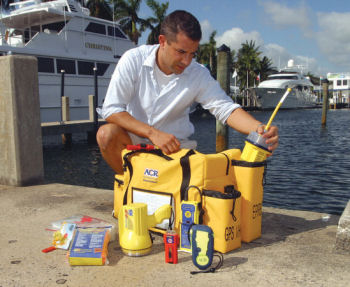 The well-equipped ditch bag could mean the difference between a close call and your last call. We give you a list of 15 “must have” emergency items. |
By Capt. John N. Raguso
Reprinted from Lifelines magazine, May 2008
Be Prepared
I’ve been making trips to the bluewater since the mid-1970s and I’ve never had to abandon ship due to weather related issues, mechanical breakdowns, hull damage or otherwise. However, there were at least a half dozen times when my passengers and I came awfully close to going into the water. Fortunately, quick thinking or a last-minute act of God has always saved us from peril and plight.
Still, it’s a fact of life that, if you boat and fish with enough frequency, sooner or later you will be confronted with a potentially compromising situation. It’s simply the law of averages.
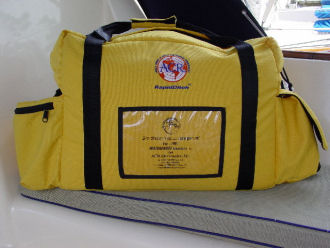 Several companies make abandon ship bags and they are not all the same, so be careful. Remember, match the contents of the bag to where you will be going. |
Given the notion that I might have to suddenly abandon ship in less than 30 seconds, I’ve often pondered what my last official act would be before hitting the DSC “Mayday” button on my VHF. Quite simply, I’d grab the “ditch bag” and stay aboard until the very last moment, when it would be clear that jumping ship would be the only viable option for survival.
Basic Components
Having learned from my brushes with danger over the years, I’ve assembled what I consider to be a workable emergency ditch bag, which is kept at the helm or within reaching distance at all times. Rather than have this kit be a suitcase full of bulky items, ranging from medical supplies and tools to food and drink, I’ve limited my emergency stash to deal with one basic question: “Besides my Type-1 PFD, what would I need in the water?”
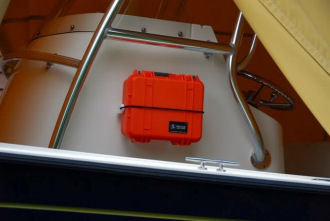 This “ditch bag” isn’t a bag at all but rather a day-glow red Pelican case and it is mounted right on the center console. It is certainly easily at hand. |
This basic survival question has led me to assemble the following components, all of which fit neatly into a handy, bright yellow, portable floating PVC case that measures less than one square foot. Keeping the limited size of this SOS ditch bag in mind, it has evolved to include the following items:
- Four (4) Cyalume 12-hour red, yellow and/or orange colored chemical light sticks
- Three self-contained handheld aerial safety flares
- Three handheld smoke flares
- Signal mirror
- Waterproof whistle
- 3-foot x 6-foot orange distress flag
- LED floating flashlight
- Container of orange water-activated signal dye
- Handheld, waterproof VHF radio with alkaline battery pack
- Handheld GPS navigator
- Leatherman Super-Tool
- Strobe light
- Personal Locator Beacon (or 406 MHz EPIRB for your boat)
- Small medical kit with aspirin and seasick pills
- One 16-oz bottle of water
Some Explanation
The Cyalume chemical light sticks are a great invention. They have a long shelf life and remain secure in foil wrappers until needed. They also have built-in loops that easily attach to snaps on your Type-1 PFDs and will glow brightly for up to 12 hours. I prefer the red, orange or yellow colors, since these will have the most contrast with the water in limited visibility situations when air rescue resources or passing ships might be looking for you.
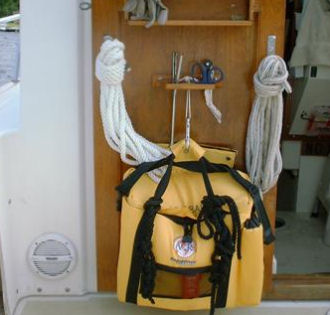 The key to stowage of a “ditch bag” is to have it “easily at hand.” |
Self-contained aerial flares that don’t require a pistol to launch are also a major plus, as is a floating flashlight. I go with the alkaline battery power in my handheld Uniden VHF, so I don’t have to worry about the Ni-Cad unit losing its charge. The alkaline batteries have a three year shelf life and will provide a minimum of ten hours of operation.
For a GPS, I go with the waterproof Magellan since it will tell me my precise position and direction of drift, which I can then communicate to anyone within VHF radio range. I also recommend Leatherman’s Super Tool as it can do a myriad of things, but its stainless steel construction will make it sink like a rock. I solve this problem by looping the case’s belt loop on the ditch bag’s carry strap. Finally, my flashing strobe is equipped with the convenience of a flashlight on the opposite end, which serves as a backup to my primary flashlight.
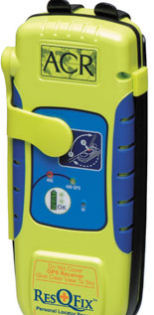 A personal locator beacon should be in your “ditch bag” with alkaline batteries. |
These items should enable you to handle many emergency situations, from communicating your exact position via the radio (using precise Lat/Long coordinates), to alerting passers-by of your plight through more conventional means.
Most important, your ditch bag should be water tight and float with all of your gear in it. Google “ditch bag” and you will find not only sources for the bag, but also some of the equipment that should go in it. Remember, your emergency ditch bag will do you no good if you can’t reach it in a hurry, so keep it nearby at all times and don’t leave port without it!